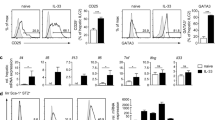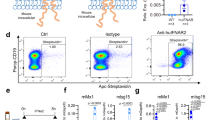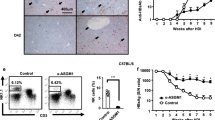Abstract
Type 1 interferon (IFN-I) promotes antigen-presenting cell maturation and was recently shown to induce hepatic IL-7 production during infection. Herein, we further explored the underlying mechanisms used by IFN-I to orchestrate antiviral immune responses in the liver. Acute viral hepatitis was induced by i.v. injection of adenovirus (Ad) in IFN-α receptor knockout (IFNAR−/−) and control mice. To disrupt signaling, monoclonal antibodies (mAbs) against IL-7 receptor alpha (IL-7Rα) or PD-L1 were i.p. injected. We found that CD8+ T cells in IFNAR−/− mice were less effective than those in control mice. The reduced T-cell function was accompanied by increased levels of PD-1 expression, apoptosis and decreased IFN-γ production. The lack of IFN-I signaling also impaired the expression of accessory molecules in both intrahepatic dendritic cell (DCs) and hepatocytes. PD-L1 was comparably and highly expressed on hepatocytes in both IFNAR−/− and control mice. Injection of PD-L1-specific mAb in IFNAR−/− mice reversed the compromised immune responses in the liver. Further investigation showed that hepatic IL-7 elevation was less pronounced in IFNAR−/− mice compared to the controls. A treatment with recombinant IL-7 suppressed PD-1 expression on CD8+ T cells in vitro. Accordingly, blocking IL-7R signaling in vivo resulted in increased PD-1 expression on CD8+ T cells in Ad-infected mice. Collectively, the results suggest that IFN-I-induced hepatic IL-7 production maintains antiviral CD8+ T-cell responses and homeostasis by suppressing PD-1 expression in acute viral hepatitis.
This is a preview of subscription content, access via your institution
Access options
Subscribe to this journal
Receive 12 digital issues and online access to articles
$119.00 per year
only $9.92 per issue
Buy this article
- Purchase on Springer Link
- Instant access to full article PDF
Prices may be subject to local taxes which are calculated during checkout





Similar content being viewed by others

References
Yang Y, Ertl HC, Wilson JM . MHC class I-restricted cytotoxic T lymphocytes to viral antigens destroy hepatocytes in mice infected with E1-deleted recombinant adenoviruses. Immunity 1994; 1: 433–442.
Guidotti LG, Borrow P, Hobbs MV, Matzke B, Gresser I, Oldstone MB et al. Viral cross talk: intracellular inactivation of the hepatitis B virus during an unrelated viral infection of the liver. Proc Natl Acad Scie USA 1996; 93: 4589–4594.
Iwai Y, Terawaki S, Ikegawa M, Okazaki T, Honjo T . PD-1 inhibits antiviral immunity at the effector phase in the liver. J Exp Med 2003; 198: 39–50.
Golden-Mason L, Palmer B, Klarquist J, Mengshol JA, Castelblanco N, Rosen HR . Upregulation of PD-1 expression on circulating and intrahepatic hepatitis C virus-specific CD8+ T cells associated with reversible immune dysfunction. J Virol 2007; 81: 9249–9258.
Hofmeyer KA, Jeon H, Zang X . The PD-1/PD-L1 (B7-H1) pathway in chronic infection-induced cytotoxic T lymphocyte exhaustion. J Biomed Biotechnol 2011; 2011: 451694.
Wherry EJ, Blattman JN, Murali-Krishna K, van der Most R, Ahmed R . Viral persistence alters CD8 T-cell immunodominance and tissue distribution and results in distinct stages of functional impairment. J Virol 2003; 77: 4911–4927.
Day CP . From fat to inflammation. Gastroenterology 2006; 130: 207–210.
Mueller SN, Vanguri VK, Ha SJ, West EE, Keir ME, Glickman JN et al. PD-L1 has distinct functions in hematopoietic and nonhematopoietic cells in regulating T cell responses during chronic infection in mice. J Clin Invest 2010; 120: 2508–2515.
Blackburn SD, Crawford A, Shin H, Polley A, Freeman GJ, Wherry EJ . Tissue-specific differences in PD-1 and PD-L1 expression during chronic viral infection: implications for CD8 T-cell exhaustion. J Virol 2010; 84: 2078–2089.
Keir ME, Liang SC, Guleria I, Latchman YE, Qipo A, Albacker LA et al. Tissue expression of PD-L1 mediates peripheral T cell tolerance. J Exp Med 2006; 203: 883–895.
Mühlbauer M, Fleck M, Schütz C, Weiss T, Froh M, Blank C et al. PD-L1 is induced in hepatocytes by viral infection and by interferon-α and -β and mediates T cell apoptosis. J Hepatol 2006; 45: 520–528.
Pinchuk IV, Saada JI, Beswick EJ, Boya G, Qiu SM, Mifflin RC et al. PD-1 ligand expression by human colonic myofibroblasts/fibroblasts regulates CD4+ T-cell activity. Gastroenterology 2008; 135: 1228–1237.e2.
Barber DL, Wherry EJ, Masopust D, Zhu B, Allison JP, Sharpe AH et al. Restoring function in exhausted CD8 T cells during chronic viral infection. Nature 2006; 439: 682–687.
Radziewicz H, Ibegbu CC, Fernandez ML, Workowski KA, Obideen K, Wehbi M et al. Liver-infiltrating lymphocytes in chronic human hepatitis C virus infection display an exhausted phenotype with high levels of PD-1 and low levels of CD127 expression. J Virol 2007; 81: 2545–2553.
Pawlotsky JM, de Erik C . Advances in Pharmacology. Vol. 67. Chapter 5: Hepatitis C Virus: Standard-of-Care Treatment. New York: Academic Press, 2013: 169–215.
Le Bon A, Etchart N, Rossmann C, Ashton M, Hou S, Gewert D et al. Cross-priming of CD8+ T cells stimulated by virus-induced type I interferon. Nat Immunol 2003; 4: 1009–1015.
Sawa Y, Arima Y, Ogura H, Kitabayashi C, Jiang JJ, Fukushima T et al. Hepatic interleukin-7 expression regulates T cell responses. Immunity 2009; 30: 447–457.
Hou L, Jie Z, Desai M, Liang Y, Soong L, Wang T et al. Early IL-17 production by intrahepatic T cells is important for adaptive immune responses in viral hepatitis. J Immunol 2013; 190: 621–629.
Lee LF, Logronio K, Tu GH, Zhai W, Ni I, Mei L et al. Anti-IL-7 receptor-alpha reverses established type 1 diabetes in nonobese diabetic mice by modulating effector T-cell function. Proc Natl Acad Sci USA 2012; 109: 12674–12679.
Penaranda C, Kuswanto W, Hofmann J, Kenefeck R, Narendran P, Walker LS et al. IL-7 receptor blockade reverses autoimmune diabetes by promoting inhibition of effector/memory T cells. Proc Natl Acad Sci USA 2012; 109: 12668–12673.
Golden-Mason L, Burton JR Jr, Castelblanco N, Klarquist J, Benlloch S, Wang C et al. Loss of IL-7 receptor alpha-chain (CD127) expression in acute HCV infection associated with viral persistence. Hepatology 2006; 44: 1098–109.
Lv G, Ying L, Ma WJ, Jin X, Zheng L, Li L et al. Dynamic analysis of CD127 expression on memory CD8 T cells from patients with chronic hepatitis B during telbivudine treatment. Virol J 2010; 7: 207.
Pellegrini M, Calzascia T, Toe JG, Preston SP, Lin AE, Elford AR et al. IL-7 engages multiple mechanisms to overcome chronic viral infection and limit organ pathology. Cell 2011; 144: 601–613.
Tang XZ, Jo J, Tan AT, Sandalova E, Chia A, Tan KC et al. IL-7 licenses activation of human liver intrasinusoidal mucosal-associated invariant T cells. J Immunol 2013; 190: 3142–3152.
Yan J, Jie Z, Hou L, Wanderley JL, Soong L, Gupta S et al. Parenchymal expression of CD40 exacerbates adenovirus-induced hepatitis in mice. Hepatology 2011; 53: 1455–1467.
Liang Y, Jie Z, Hou L, Aguilar-Valenzuela R, Vu D, Soong L et al. IL-33 Induces nuocytes and modulates liver injury in viral hepatitis. J Immunol 2013; 190: 5666–5675.
Zhu J, Huang X, Yang Y . Type I IFN signaling on both B and CD4 T cells is required for protective antibody response to adenovirus. J Immunol 2007; 178: 3505–3510.
Yamazaki T, Akiba H, Iwai H, Matsuda H, Aoki M, Tanno Y et al. Expression of programmed death 1 ligands by murine T cells and APC. J Immunol 2002; 169: 5538–5545.
Zhu J, Huang X, Yang Y . A critical role for type I IFN-dependent NK cell activation in innate immune elimination of adenoviral vectors in vivo. Mol Ther 2008; 16: 1300–1307.
Jiang Q, Li WQ, Aiello FB, Mazzucchelli R, Asefa B, Khaled AR et al. Cell biology of IL-7, a key lymphotrophin. Cytokine Growth Factor Rev 2005; 16: 513–533.
Mazzucchelli R, Durum SK . Interleukin-7 receptor expression: intelligent design. Nat Rev Immunol 2007; 7: 144–154.
Barbier L, Tay SS, McGuffog C, Triccas JA, McCaughan GW, Bowen DG et al. Two lymph nodes draining the mouse liver are the preferential site of DC migration and T cell activation. J Hepatol 2012; 57: 352–358.
Jooss K, Ertl HC, Wilson JM . Cytotoxic T-lymphocyte target proteins and their major histocompatibility complex class I restriction in response to adenovirus vectors delivered to mouse liver. J Virol 1998; 72: 2945–2954.
Sun J, Tumurbaatar B, Jia J, Diao H, Bodola F, Lemon SM et al. Parenchymal expression of CD86/B7.2 contributes to hepatitis C virus-related liver injury. J Virol 2005; 79: 10730–10739.
Huang L, Soldevila G, Leeker M, Flavell R, Crispe IN . The liver eliminates T cells undergoing antigen-triggered apoptosis in vivo. Immunity 1994; 1: 741–749.
Schluns KS, Kieper WC, Jameson SC, Lefrancois L . Interleukin-7 mediates the homeostasis of naive and memory CD8 T cells in vivo. Nat Immunol 2000; 1: 426–432.
Rubinstein MP, Lind NA, Purton JF, Filippou P, Best JA, McGhee PA et al. IL-7 and IL-15 differentially regulate CD8+ T-cell subsets during contraction of the immune response. Blood 2008; 112: 3704–3712.
Schluns KS, Williams K, Ma A, Zheng XX, Lefrancois L . Cutting edge: requirement for IL-15 in the generation of primary and memory antigen-specific CD8 T cells. J Immunol 2002; 168: 4827–4831.
Dong H, Zhu G, Tamada K, Flies DB, van Deursen JM, Chen L . B7-H1 determines accumulation and deletion of intrahepatic CD8+ T lymphocytes. Immunity 2004; 20: 327–336.
Acknowledgements
We thank Ms Mardelle Susman for her editorial assistance. None of the authors has a conflict of interest. LH, ZJ, YL and DM performed the experiments; LH, ZJ, YL, LS and JS analyzed the data: LH, YL, DM, LS and JS wrote the paper. This work was supported by the National Institutes of Health grant AI109100 (JS). ZJ was in part supported by the James W. McLaughlin Fellowship and the UTMB Graduate School of Biomedical Sciences.
Author information
Authors and Affiliations
Corresponding author
Ethics declarations
Competing interests
The authors have declared no competing interests.
Rights and permissions
About this article
Cite this article
Hou, L., Jie, Z., Liang, Y. et al. Type 1 interferon-induced IL-7 maintains CD8+ T-cell responses and homeostasis by suppressing PD-1 expression in viral hepatitis. Cell Mol Immunol 12, 213–222 (2015). https://doi.org/10.1038/cmi.2014.49
Received:
Revised:
Accepted:
Published:
Issue Date:
DOI: https://doi.org/10.1038/cmi.2014.49
Keywords
This article is cited by
-
Recombinant chicken interleukin-7 as a potent adjuvant increases the immunogenicity and protection of inactivated infectious bursal disease vaccine
Veterinary Research (2018)
-
IL-7 and CCL19 expression in CAR-T cells improves immune cell infiltration and CAR-T cell survival in the tumor
Nature Biotechnology (2018)
-
Type I interferons drive inflammasome-independent emergency monocytopoiesis during endotoxemia
Scientific Reports (2017)
-
Immunomodulatory and anticancer potential of Gan cao (Glycyrrhiza uralensis Fisch.) polysaccharides by CT-26 colon carcinoma cell growth inhibition and cytokine IL-7 upregulation in vitro
BMC Complementary and Alternative Medicine (2016)


